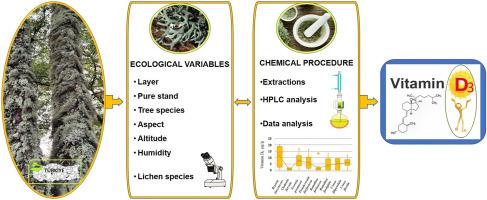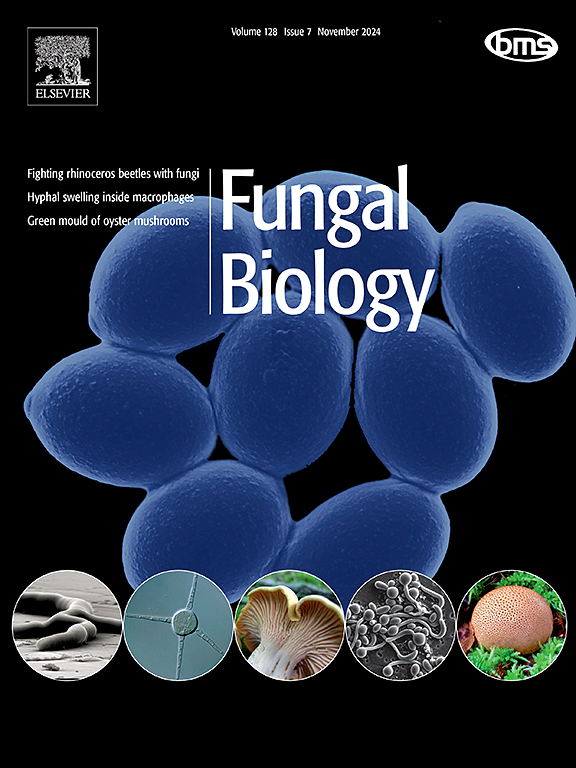探索森林生态系统中附生地衣形成真菌的维生素D3谱:生境依赖生态变量的影响
IF 3
3区 生物学
Q2 MYCOLOGY
引用次数: 0
摘要
维生素D对人类的可持续健康至关重要,与维生素D缺乏有关的疾病日益流行,这增加了人们对天然来源的兴趣。本研究探索了附生地衣形成真菌的潜力,以其独特的代谢物而闻名,作为维生素D3的新型生物来源,用于制药和营养保健应用。采用分层抽样的方法,在云南省马尔马拉地区的4个山地森林中采集了14种附生地衣。分析了样品中维生素D3含量与6个生态变量的关系:研究区层、林分类型、树种、海拔、坡向、空气湿度和温度。采用浸渍法、索氏法、超临界CO2法提取,HPLC法分析。橄榄油基浸渍法是最有效的提取方法。单因素方差分析显示,维生素D3含量与地衣种类(p = 0.024)、地衣层数、地衣林分和地衣树种之间存在显著相关。浓度范围为0.6 ~ 20.33 μg/g,以褐僵菌、樱腐菌和糠皮假菌含量最高。乌鲁达乌木的维生素D3水平最高,特别是在以黑松为主的针叶林中。结果表明,林层、林分、海拔和树种对维生素D3含量有显著影响,而坡向和湿度对维生素D3含量无显著影响。这是首次全面报道地衣中天然维生素D3含量的研究,填补了重要的科学空白,并证明了地衣作为一种生态可持续的维生素D3生产资源的潜力本文章由计算机程序翻译,如有差异,请以英文原文为准。

Exploring vitamin D3 profile of epiphytic lichen forming fungi in forest ecosystems: Influence of habitat-dependent ecological variables
Vitamin D is critically important for sustainable human health, and the rising prevalence of deficiency-related diseases has increased interest in natural sources. This study explores the potential of epiphytic lichen-forming fungi, known for their unique metabolites, as a novel biosource of vitamin D3 for pharmaceutical and nutraceutical applications. Fourteen epiphytic lichen species were collected using a stratified sampling method from four mountainous forests in the Marmara Region of Türkiye. Vitamin D3 contents of the samples were analysed in relation to six ecological variables: study area layer, stand type, tree species, altitude, aspect, and air humidity and temperature. Extraction methods including maceration, Soxhlet, and supercritical CO2 techniques were applied, followed by HPLC analysis. Olive oil-based maceration was identified as the most efficient extraction method. One-way ANOVA showed significant associations between vitamin D3 content and lichen species (p = 0.024), layer, stand, and tree species. Concentrations ranged from 0.6 to 20.33 μg/g, with Bryoria fuscescens, Evernia prunastri, and Pseudevernia furfuracea yielding the highest values. The highest vitamin D3 levels were detected in Uludağ, especially in coniferous forests dominated by Pinus nigra. The results indicated that forest layer, stand, altitude, and tree species significantly influence vitamin D3 amounts, while aspect and humidity do not. This is the first study to comprehensively report natural vitamin D3 content in lichens, filling an important scientific gap and demonstrating their potential as an eco-sustainable resource for vitamin D3 production
求助全文
通过发布文献求助,成功后即可免费获取论文全文。
去求助
来源期刊

Fungal biology
MYCOLOGY-
CiteScore
5.80
自引率
4.00%
发文量
80
审稿时长
49 days
期刊介绍:
Fungal Biology publishes original contributions in all fields of basic and applied research involving fungi and fungus-like organisms (including oomycetes and slime moulds). Areas of investigation include biodeterioration, biotechnology, cell and developmental biology, ecology, evolution, genetics, geomycology, medical mycology, mutualistic interactions (including lichens and mycorrhizas), physiology, plant pathology, secondary metabolites, and taxonomy and systematics. Submissions on experimental methods are also welcomed. Priority is given to contributions likely to be of interest to a wide international audience.
 求助内容:
求助内容: 应助结果提醒方式:
应助结果提醒方式:


